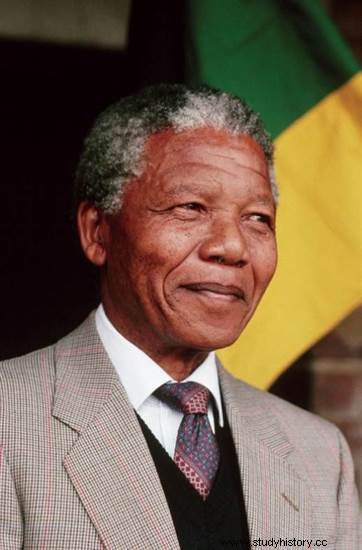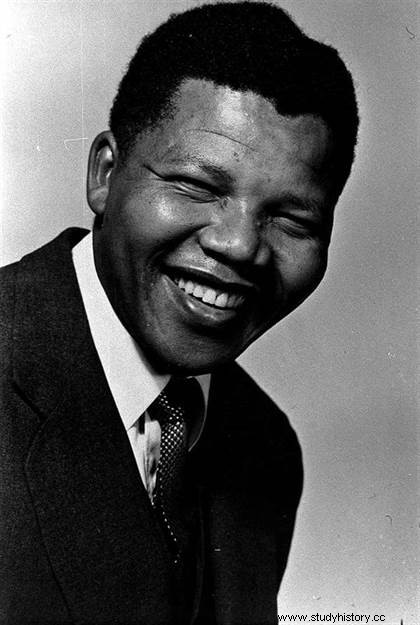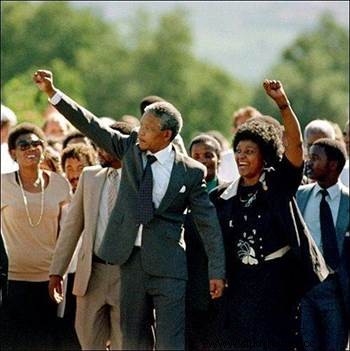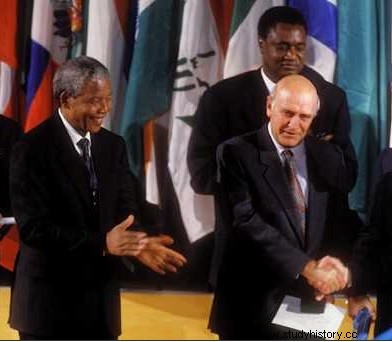 Nelson Mandela is a South African politician, a symbolic figure in the struggle against apartheid. Sentenced to life imprisonment in 1964, he was released in 1990 by President Frederik De Klerk. The two men together received the Nobel Peace Prize in 1993. In 1994, Nelson Mandela won the presidential election and became the first black president of South Africa (1994-1999). At the head of a rainbow nation, he is the last of the giants of the 20th century. After the publication of his Memoirs under the title A long road to freedom , in 2005 he became a UNESCO Goodwill Ambassador and, in 2006, an Ambassador of Conscience for Amnesty International. His disappearance in 2013 gave rise to a funeral of international significance.
Nelson Mandela is a South African politician, a symbolic figure in the struggle against apartheid. Sentenced to life imprisonment in 1964, he was released in 1990 by President Frederik De Klerk. The two men together received the Nobel Peace Prize in 1993. In 1994, Nelson Mandela won the presidential election and became the first black president of South Africa (1994-1999). At the head of a rainbow nation, he is the last of the giants of the 20th century. After the publication of his Memoirs under the title A long road to freedom , in 2005 he became a UNESCO Goodwill Ambassador and, in 2006, an Ambassador of Conscience for Amnesty International. His disappearance in 2013 gave rise to a funeral of international significance.
Biography of Nelson Mandela
Nelson Rolihlahla Mandela was born in 1918 in the Cape Province and descended from a Xhosa royal line, young Nelson Mandela was the first in his family to receive a Western education . Law student, this sportsman, convinced Christian and admirer of the thought of Gandhi, adheres to the ideas of African nationalism which aims at the emancipation of the black populations from the colonial yoke and joins the ANC. These theses were put to the test in South Africa, when in 1948 the country adopted segregationist legislation:Apartheid. Until 1991, the South African population was divided into four groups that were systematically excluded from each other:blacks, mestizos, whites and Indians.
 Mandela, one of the first black lawyers in the country, distinguished himself within the ANC by organizing campaigns of civil disobedience in 1952. Several times arrested, watched by the authorities, he nevertheless continued his subversive activities. Faced with increasingly violent repression (Sharpeville massacre in 1960), Mandela ended up advocating, after long hesitation, armed struggle against the Pretoria regime. He will be the organizer of a bomb sabotage campaign which will earn him to be arrested again on August 5, 1962.
Mandela, one of the first black lawyers in the country, distinguished himself within the ANC by organizing campaigns of civil disobedience in 1952. Several times arrested, watched by the authorities, he nevertheless continued his subversive activities. Faced with increasingly violent repression (Sharpeville massacre in 1960), Mandela ended up advocating, after long hesitation, armed struggle against the Pretoria regime. He will be the organizer of a bomb sabotage campaign which will earn him to be arrested again on August 5, 1962.
His trial and that of several ANC leaders (Rivonia trial) was held in Rivoria from 1963 to 1964. Despite a brilliant defense, Mandela was sentenced to prison at perpetuity. Locked up on the Prison Island of Robben Island, Mandela would later become a world icon in the fight for racial equality. In the 1980s the Apartheid regime, increasingly isolated internationally, chose him as its interlocutor to put an end to the unrest in the country.
Nelson Mandela, a famous figure in the anti-apartheid struggle
 It was on February 11, 1990 that Nelson Mandela was released from prison, greeted triumphantly by his supporters and his wife Winnie Madikizela Mandela. After 27 years of imprisonment, the leader of the ANC will take the head of the movement which in four years will dismantle the apartheid regime. This racial policy of separate development had been officially introduced in 1948 (although racial segregation dates back to the origins of South Africa, three centuries earlier), and had caused South Africa to be gradually banished. of the international community (officially at least, because it remained a pillar of anti-Soviet containment in Africa).
It was on February 11, 1990 that Nelson Mandela was released from prison, greeted triumphantly by his supporters and his wife Winnie Madikizela Mandela. After 27 years of imprisonment, the leader of the ANC will take the head of the movement which in four years will dismantle the apartheid regime. This racial policy of separate development had been officially introduced in 1948 (although racial segregation dates back to the origins of South Africa, three centuries earlier), and had caused South Africa to be gradually banished. of the international community (officially at least, because it remained a pillar of anti-Soviet containment in Africa).
Resulting from a radicalization of Calvinist theology and Afrikaner nationalism, apartheid results in reality in very harsh living conditions for non-whites, very limited in their possibility of social and economic evolution (in particular by their relegation within specific geographical areas). Within the country, this policy led to strong resistance, the most well-known movement of which remains Mandela's ANC. The repression, as we know, was sometimes terrible. In the 1980s the Apartheid regime, increasingly isolated internationally, chose him as its interlocutor to put an end to the unrest in the country.
South Africa's first black president
Mandela leads the negotiations with South African President Frederik de Klerk that will lead to the end of apartheid in 1991. Nobel Peace Prize in 1993, then elected President of the Republic of South Africa, he will face the challenges of economic and social reconstruction of a country plagued by racism, poverty and AIDS.
 With the desire to establish a stable multiracial democracy, Mandela is working above all to succeed in his challenge of reconciliation and peaceful coexistence between the different components of the "rainbow people" of South Africa. To this end, he set up the Truth and Reconciliation Commission to shed light on the human rights violations perpetrated under apartheid. In order to correct the evils of apartheid, he applied a policy of positive discrimination aimed at favoring the black population in terms of employment and launched a program for the development of basic services (access to education, housing, water, electricity).
With the desire to establish a stable multiracial democracy, Mandela is working above all to succeed in his challenge of reconciliation and peaceful coexistence between the different components of the "rainbow people" of South Africa. To this end, he set up the Truth and Reconciliation Commission to shed light on the human rights violations perpetrated under apartheid. In order to correct the evils of apartheid, he applied a policy of positive discrimination aimed at favoring the black population in terms of employment and launched a program for the development of basic services (access to education, housing, water, electricity).
Furthermore, the army was profoundly rebalanced with the appointment, in 1998, of a new black chief in charge of integrating former ANC combatants into the forces regular. The government's desire to correct the evils of apartheid in favor of blacks is expressed by the establishment of racial quotas in public establishments inspired by American affirmative action (positive discrimination) or by the black empowerment program consisting in favoring the formation of a class of black businessmen.
These measures are not without concern for the white population, which considers itself to be the victim of reverse segregation. Nor do they meet the expectations of the black majority, eager to reap the fruits of the reforms.
Mandela's withdrawal from politics and death
After marrying Graça Machel, a political figure in Mozanbique, in 1998, Mandela left office in favor of his successor Thabo Mbeki and became a private citizen again in 1999. He has since worked in in various charities, particularly in the fight against poverty. Despite a mixed record in terms of the political, economic and social reconstruction of his country, he is still considered one of the great "wise men" of the African continent.
Nelson Mandela died on December 5, 2013. To pay tribute to him, a grand official ceremony was organized on December 10, 2013 in Soweto in the presence of a hundred heads of state. and government, in a crowded and emotional stadium.
Bibliography
- Nelson Mandela's Long Walk to Freedom, Autobiography. Pocket, 1996.
- Nelson Mandela:The Last Titan by Alfred Bosch. The Harmattan, 1997.
- Mandela, a destiny, biography of Bernard Violet. I read, 2013.
